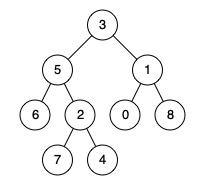题目描述
给定一个二叉树, 找到该树中两个指定节点的最近公共祖先。
百度百科中最近公共祖先的定义为:“对于有根树 T 的两个节点 p、q,最近公共祖先表示为一个节点 x,满足 x 是 p、q 的祖先且 x 的深度尽可能大(一个节点也可以是它自己的祖先)。”
示例:
5和1的公共祖先是3
5和4大公共祖先是5
思路
递归,设root为最近公共祖先,那么只有以下三种情况:
- p, q分别在root的不同侧;
- root == p, q是p的后代;
- root == q, p是q的后代
那么我们递归的核心思路就是:
- 传入root结点和p,q结点,如果p在root的左子树(或者右子树),q在root的右子树(或者左子树中),返回root, root就是最近公共结点。
- p或者q如果都不在root的左子树或者右子树中,则返回null
- p如果在root的左子树或者右子树中,但是q不在,返回p结点;
- q如果在root的左子树或者右子树中,但是p不在,返回q结点;
PS: 该题不是很理解代码,先背下来
代码
class Solution {public TreeNode lowestCommonAncestor(TreeNode root, TreeNode p, TreeNode q) {// 终止条件// 1. root == null : 无结点了// 2. root == p; 传入的结点等于p结点// 3. root == q; 传入的结点等于q结点if (root == null || root == p || root == q) {return root;}TreeNode left = lowestCommonAncestor(root.left, p, q);TreeNode right = lowestCommonAncestor(root.right, p, q);if (left == null && right == null) {return null;}if (left == null) {return right;}if (right == null) {return left;}return root;}}

